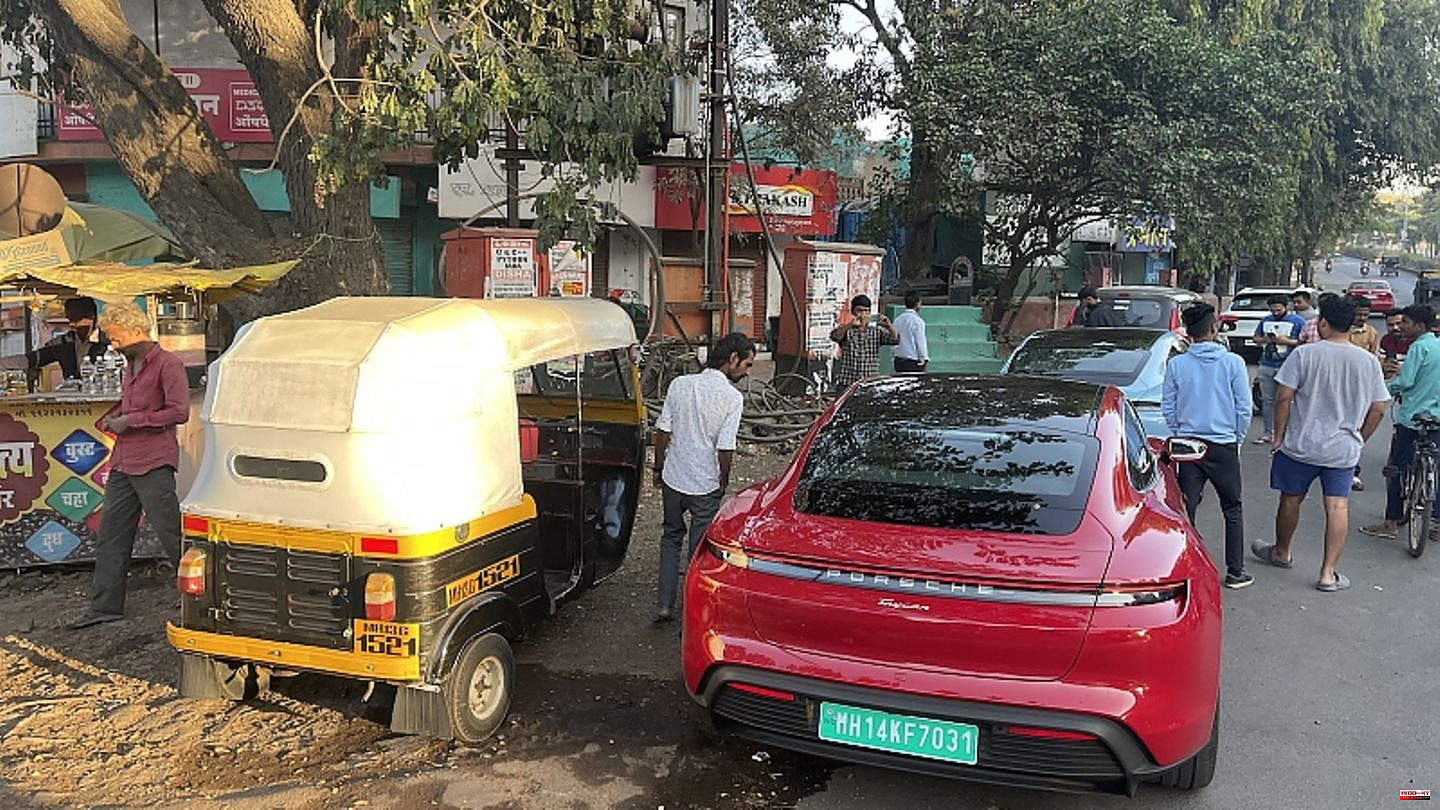It's hard to believe for anyone driving the streets of India that this market will one day be electrified. In the metropolises of Chennai, Mumbai, Pune and Delhi, hundreds of thousands of cars push their way down streets that are far too narrow. Where there are three lanes, five to seven cars, rickshaws and scooters drive side by side. Horns are honked wildly and orderly chaos reigns, because nobody is tense behind the wheel here. Thick clouds of exhaust fumes come from the mufflers of the rattling trucks and scooters. Electro seems a long way off until the first Tata Nexon appears in the Mumbai port area.
“EVs are still in the early stages in India. While affordable EVs are gaining momentum, high import tariffs make it difficult for luxury automakers to import vehicles as CBUs to monitor market trends and customer buying behavior,” says Bakar Sadik Agwan, analyst at Global Data Tesla and Mercedes have expressed concern about the world's highest taxes, making their vehicles up to twice as expensive compared to developed markets like the US and Europe, making them unaffordable in India. Setting up assembly/production for a small volume segment does not make economic sense for these luxury car manufacturers. Limited imports could help to gauge the market and finally plan their future strategies. The race to electrification in India is not a short sprint, but a marathon that requires careful planning and execution."
Skoda has the Indian market firmly in its sights and has its hat on for the entire Volkswagen Group. It starts small and gets bigger and bigger. For example, one of the largest solar roofs in the billionaire state is on the Skoda production line. The lush sunshine on the roof recently produced 26.6 million kilowatt hours of energy. This means that almost a third of the energy requirements for production can be covered by solar power. That would be enough to drive 182 million kilometers in an electric Skoda Enyaq. The road to Indian electromobility won't be quite that long, but hardly any less difficult. But the growth rates are impressive.
While there were just 20,000 electric vehicles on Indian roads in 2018, more than 300,000 electric cars were sold last year. The manageable number of charging stations remains a problem. Although the country with its almost 1.4 billion inhabitants transports millions of scooters, rickshaws and cars on its roads, there are currently not even 1,800 charging stations. The Indian government has big plans for the coming years. By 2030, a third of all newly registered vehicles should be electric. The number of charging stations is expected to increase to 100,000 units by 2027.
The Volkswagen Group has had its sights set on India as a potential market for more than 20 years, but the subcontinent has not really taken off yet. In India, VW operates two production plants in Pune / Chakan and Aurangabad / Shendra with a total production capacity of over 240,000 vehicles. With its five brands represented, the Volkswagen Group sold almost 135,000 vehicles in India last year – an increase of 86 percent. The group employs 6,000 people in India and is indirectly responsible for employing a further 25,000 people at dealers and suppliers. Since 2001, Skoda has been particularly successful with its Octavia, Fabia and Rapid models, most of which are manufactured locally. Now the focus is on the Kushaq and Slavia models, of which. 95 percent are localized in order to be able to enforce the favorable national prices. In addition to the Porsche Macan, the two Audi models Etron and Etron GT are also in the electric range.
The Volkswagen Group and market leader Mahindra signed a contract last August to supply MEB electrical components for Mahindra's new electric SUVs. In addition, both groups are exploring further possibilities for cooperation in the field of electromobility. This should focus in particular on local vehicle projects, charging and energy solutions as well as cell production. Years ago, a far-reaching stake (19.9 percent) held by Volkswagen in Suzuki, with which the Wolfsburg-based company wanted to land in particular on the Indian continent, failed. Suzuki is a close cooperation partner of market leader Maruti in India. But the project collapsed in 2015 after years of litigation.
Stellantis is also increasingly drawn to India. The multi-brand group with companies such as Peugeot, Fiat, Opel, Citroen and Jeep promises good business, especially with the inexpensive brands. There are currently local factories in Ranjangaon, Hosur and Thiruvallur, as well as two development centers in Chennai and Pune. However, the number of employees at 3,000 is still manageable for such a gigantic market. Citroen wants to attract new customers with a locally produced C3 in what is currently the third largest single market in the world. “The new C3 is an essential part of this international expansion and the first stage of the growth strategy. The vehicle, less than four meters long, is aimed at an important segment in India and South America," says Citroen CEO Vincent Cobée. "Modern, connected and tailored to local needs, the new C3 is perfectly suited to support Citroen's growth ."
For many car manufacturers, India has long been considered a market that is just as promising as China once was – they are now the undisputed number one in the world. The Indian market is growing again after a pandemic-related crash - but so far there has not been the boom that many were hoping for. The premium brands from Europe are having a particularly difficult time. BMW was pleased to see a 35 percent increase in sales to just under 12,000 vehicles earlier this year - not much for such a large market and the fact that BMW's Chennai plant now produces 13 models. In addition to the 2-series Gran Coupé, the 3-series, 5-series, 6-series, 7-series, X1, X3 / X4, X5 / X7 and Mini Countryman are also manufactured in CKD in order to avoid the gigantic taxes on imports. It doesn't look much different at Mercedes. The Stuttgart carmaker sold almost 16,000 vehicles in 2022 - but the reason for the impressive increase of 41 percent was a poor previous year in 2021. This means that the number is at the same level as in 2017 or 2018. In 2020, Mercedes launched its first electric model with its EQC . The Swabians now also offer the AMG EQS 53, the EQB 300 and – locally produced – the Mercedes EQS 580. Currently with an electrical component of less than three percent. However, the Indian sales organization is anticipating a multiplication to up to 25 percent in the next four years. Because there are problems with the charging network, Mercedes has found its own solution. With 140 AC and some DC fast chargers, MB India offers the largest fast charging network for luxury cars. However, only Mercedes customers can currently use this.
Porsche sold 779 vehicles last year - with an electric share of ten percent. Electric cars are still a rarity in India - no wonder the bright blue Porsche Taycan stands out like a sore thumb on the streets of Pune. Hardly a scooter or a rickshaw passes the crowded streets of the five-million metropolis without their mobile phone cameras being pulled out. Young Indians in particular bend low over the Stuttgart electric car when they stop at traffic lights to take a selfie. The price of the Taycan in India is around 2.5 times higher than in its production country Germany - at least 13,200,000 rupees plus corresponding taxes mean the equivalent of around 260,000 euros. Despite all the poverty, there is enough money, because the subcontinent is in third place worldwide with officially reported 166 billionaires. The number of people with net worth of $30 million or more also increased by 11 percent in 2021; the highest percentage growth in Asia Pacific.
The government not only wants to get luxury customers into electric cars and even if the vehicles on the streets are getting younger - the current lifespan of an Indian car is nine to twelve years. After all, the age of the combustion engine tuk-tuks is coming to an end and from 2026 the popular means of transport will only be on the road with electric drives. The first models can also be seen here in the dusty inner cities. But the road to electromobility will be longer than in many other Asian countries.












